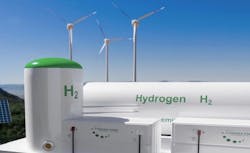Black & Veatch contributing development insights for Green Hydrogen project in Ireland
Mercury Renewables has signed up engineering firm Black & Veatch for its first-of-a-kind green hydrogen generation plant on the border of Counties Mayo and Sligo, Ireland.
Mercury Renewables will leverage Black & Veatch’s hydrogen and renewable energy expertise for this project, which is one of Ireland’s first co-located onshore wind farm and hydrogen electrolysis plants.
The project will use a 75-MW wind farm to power an electrolyzer plant to produce green hydrogen. The initial role of Black & Veatch will be the conducting of feasibility studies for the project.
The early involvement of the firm in the project will help Mercury Renewables understand what combination of electrolyzer technology and size, hydrogen storage and transport options will help meet the outlined business goals. This will be made possible through multiple scenario studies and conceptual site layouts.
“Hydrogen project developers and investors need confidence in the quality of the advice they receive. The most complete analysis will come from partners with expertise in hydrogen, renewable energy generation, and the complex interfaces between them that define projects like Firlough,” said Youssef Merjaneh, Black & Veatch’s Senior Vice President, Managing Director, Europe, Middle East & Africa.
Black & Veatch will also outline the design for the facility, taking into consideration the local surroundings, support community engagement and ensure safe operation of the plant.
“The abundance of renewable energy potential in Ireland means green hydrogen should play a significant role in regional and national cross-sector decarbonization. Projects like Firlough put Mercury at the vanguard of delivering Ireland’s hydrogen economy,” said Tim Bills-Everett of Mercury. “Our business model is to combine local knowledge with international best practice in renewable energy development. For Firlough we also need proven hydrogen expertise. With a deep track record in both, Black & Veatch is our partner of choice.”
Last year, Mercury Renewables anticipated that the project would cost about 200 million Euros, or $211M U.S. by current exchange rates.
